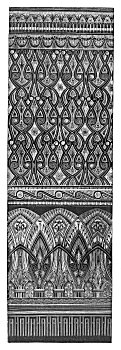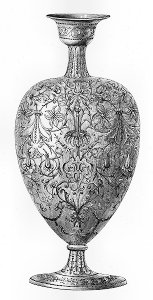|
For the International Exhibition of 1862 Wallis again acted as a commissioner. He superintended the arrangement of the textile displays and was the Deputy Commissioner for Juries of the Textile Group. For the Midland Counties Herald he wrote a long series of articles about the exhibition which he revised and reprinted. In the introduction to this report Wallis inveighs against the manufacturers, who "found no fixity of principle or action and, as a matter of course, followed the whims and caprices of fashion, enquired what would 'sell' best ...". And, of course, others in the chain of commerce were not exempt from criticism: "The wholesale buyer and the retailer became the arbiters of taste ... without any other qualification for the task except of great business tact in making the best possible commercial use of the public ignorance of art". Wallis is, of course, saying that no one ever went bankrupt underestimating the taste of the British public. He is acutely aware that if neither the manufacturers, nor the wholesalers, nor the retailers, nor the buying public had any taste, how could you break the chain and at which link in it should you start? We have already seen, in the case of the inverted gooseberry bush, that one useful point of attack was the general public. And much later in this report Wallis reverts to this: "Art education begun in the household, arising out of the little elegancies of everyday life with which a people may be surrounded through the intelligent use of design in manufactures, will do more to refine and elevate the taste of a nation than exceptional statues or equally exceptional pictures and buildings which, however excellent in themselves, create more astonishment than real interest and produce more wonder than they give instruction". Of course art schools were another approach. "It is one of the functions of Schools of Art [to give] instruction in the first principles of design" and to "train students to the point at which they may be fitted ... to be considered useful as industrial designers". But you have to bear in mind that "the fact is that ornamental art requires a special and distinct course of study, not only in its general application as part of a sound artistic education in our schools, but also in its special application to the varied products of our own great centres of manufacture".
Wallis's courses of instruction for budding designers always included plenty of work on the fine arts, and he approved of industrial art exhibitions having works of fine art in them. But he was also anxious to dispel any idea that fine art was the only form of art and and to make it clear that applied art was still art. In his 1880 article "Original Designs for Art Manufacture" he says:
The problem with art schools as a means of breaking the chain of bad taste was that the designers produced from such schools would have to find employment with manufacturers if they were to have any effect. It is possible that there is an example of this in operation, appearing later in Wallis's report. In discussing the exhibits from Wolverhampton he mentions two large manufacturers of japanned wares. Of Henry Loveridge and Co's products he uses such phrases as "very practical and useful", "neatness of finish", "appropriateness of form", "good taste in the ornamentation", "very chaste and elegant in design" and "the ornamentation being intelligent and well drawn". On the other hand, of Edward Perry's products he says: "the great mass of the objects were sadly overdone"; and "there was more than an ordinary amount of bad drawing in the details. Has the School of Art [sc. at Wolverhampton] really been of no use in teaching the elements of linear form? Design is another matter; but surely japanners might learn to delineate simple details with accuracy! That is to say, if they will condescend to be taught at all". This seems inconsistent unless the criticism of Perry is seen as specific to him and his firm. Loveridge was a leading light in, and financial supporter of, the Wolverhampton School of Art and consistently took a keen interest in design. It seems more than likely that Wallis would have thought, or would like to have thought, that Loveridge was employing students from the Art School or sending his japanners there, and was reaping the benefits; and Perry was not condescending to have any taught at all, and was showing the result. If we may skip ahead slightly to the Wolverhampton Exhibition of 1864, on which Wallis also reported, we find that Loveridge's work was "of an excellent character and make, perfect in form, surface and finish" and Perry had now crept up to being "generally well designed". Even further ahead it may be significant that later, when Edward Perry had died and his firm had been absorbed into that of his nephews, Richard Perry, Son and Co, they felt the need to employ an outside consultant designer, Christopher Dresser. There is no evidence that Loveridge's ever did. Whatever the limitations of fine art in educating the public, industrial art exhibitions were, of course, a more powerful tool to break the chain of bad taste. Commenting on the Wolverhampton Industrial Exhibition of 1864 Wallis says: "No such collection has ever been got together in Wolverhampton before and the effect on public taste of the district cannot fail to be of great value and importance in the future. ... The youth of the district ... will not be likely to forget the works of beauty and grace so profusely placed before them, the examination of which must have been a new pleasure, in connection with a new lesson, easily learnt and easily remembered". An important feature of the report on the 1862 International Exhibition is that in it Wallis provides us with the only statement (so far found) of the principles of design which he espoused and promoted. There are three "principles" to consider when designing anything:
Wallis then sets out these "principles" in further detail - though two of them become "propositions" in the process. These are worth setting out in extenso:
Wallis makes it clear that the form of an object must be primarily functional and that grace of line and proportions come second.
Presumably considering the material in all its bearings would cover choosing the most appropriate material for the use to which the object is to be put; and then the ornamentation must be appropriate to that material. Wallis gives glass as an example. You ask first if glass is appropriate to the proposed use; and, if it is, you then cut the glass to shows its brilliance and light by using facets - you do not cover it with acanthus leaves.
In other words, you have to understand the production process and what it can and cannot do and what it is economical to do. These principles and propositions are not exactly pellucid. Wallis's problem with expressing them seems to derive from his awareness that none of them is independent of the others and that there is not a sequential step by step process which can be followed: any amount of back tracking and feedback might be required to get the right result. |
|||



